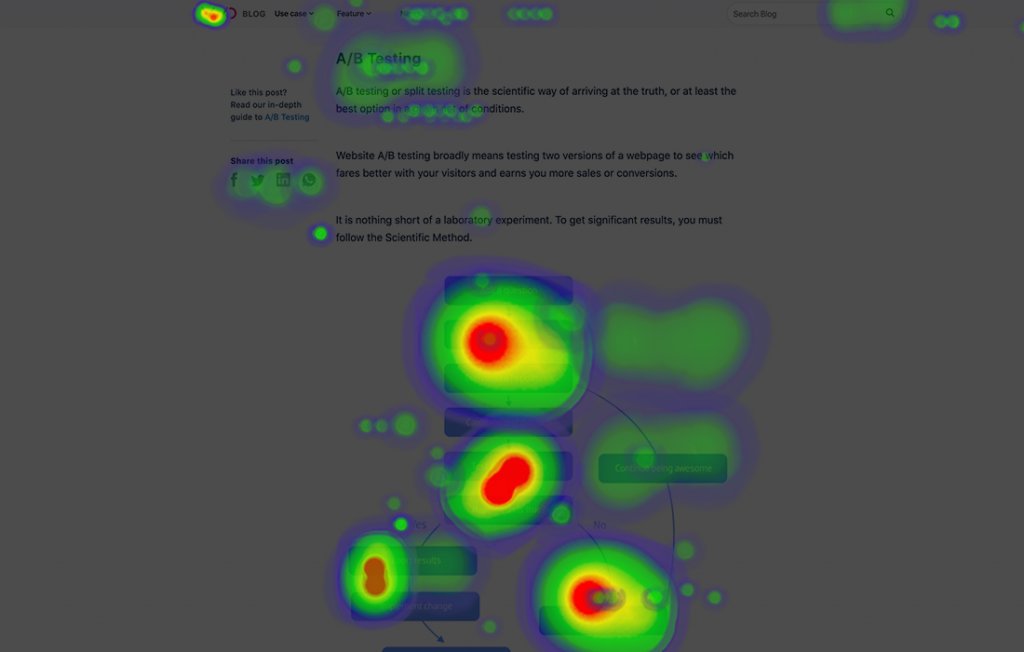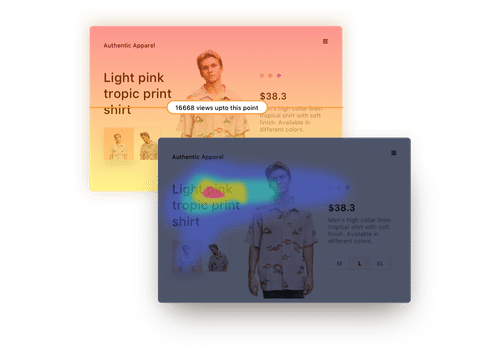What is Mouse Heatmap? Benefits, Tools, and Examples
Website heatmaps are unarguably one of the most fascinating and insightful web behavior analytics tools and use colors to simplify even complex data sets – mouse heatmap is part of this family. In a heatmap, each value in the data matrix is visualized with a corresponding color that signifies its level of engagement with website visitors.
In addition to offering mouse movement heatmaps, website heatmaps offer scrollmap to gauge content engagement, clickmap to track and analyze click data, classic heatmap for overall page performance, and eye tracking heatmaps to capture gaze frequency and fixation length – eye-tracking heatmaps are often confused with mouse heatmaps though. Their use cases are widely different, and this blog attempts to educate readers around the nature of these differences.
Download Free: Website Heatmap Guide
This blog also aims to navigate your way through what mouse heatmaps are, why they are important, and how it’s insights differ from the straightforward scroll and click insights that other heatmap types offer. We’ll also leave you with a list of the most popular and robust mouse heatmap tools to choose from for your mouse heatmap exercise
What is mouse heatmap and why is it important?
Mouse heatmap visually represents visitors’ mouse movement data using thermal imaging – it records where visitors are hovering, clicking, scrolling, and pausing through your web pages. It is often also referred to as mouse tracking heatmap, mouse movement heatmap, hover map, attention map, attention heatmaps, or move maps.
By leveraging mouse heatmaps, one can identify hover patterns that can help discover areas of high visitor frustration and reading struggles. Such insights are especially useful when seeking to optimize complex web pages made up of text, images, varied dynamic elements, and more.
The trending discussion at this hour around mouse heatmap pertains to its interchangeability with eye tracking heatmap or if the former can be a more scalable alternative to the latter. Even though the contribution that both these heatmaps make towards gauging webpage usability and user attention, there is one added promise mouse heatmaps offer that eye tracking heatmaps don’t – “the ability to estimate the relevance of search results in the presence or absence of clicks for improving search relevance estimation, to study web usability design and to determine preferred reading regions that help in inferring which portions of long documents receive more user attention.”
Let us look as more such applications of mouse heatmaps that make it an equally good if not a better alternative to other website heatmap types:
1. Predict and measure user experience
By tracking and visualizing users’ mouse or cursor movement trends, mouse heatmaps help uncover insights that offer signals to predict whether your website’s user experience (UX) is good or not, to infer user attention pattern in complex pages, and how it may be different for varying page layout, to identify popular part of the page that grabs the most attention, and to identify distractions. Given below is a heatmap plotted on one of our blogs:

The heatmap shows that visitors paused the most over the images in the blog when compared to other sections. Among other things, this means that the images or the section in which the images were placed were capturing more visitors’ attention. Insights like these can expedite the decision-making process by providing data-backed actionables.
Such a multitude of data serves as an idea repository that can be revisited time and again to look for solutions to experience breakage.
2. Take cues to influence decision making
Mouse heatmaps function more on observing the psyche behind actions rather than on the mere behavioral observation of choices. While other heatmap types track and represent on-site choices/actions that visitors make, the scope of mouse heatmaps extends beyond this to take into consideration the process behind the choices/actions. What this means is that for every choice made, the mouse movement made towards or away from the other available alternative actions signals that those alternatives were also considered during the decision-making process. By helping you trace the entire process, mouse movements help you make changes in your interface or product that have a greater impact on visitor attention.
An eCommerce analyst can take a quick look at the mouse movement pattern right before visitors drop off from their checkout page to identify elements that almost caught their attention but failed to be captivating enough to retain it, and then optimize those elements so that the next visitor from that segment finds it rather interesting to stick around longer or to click it and convert. For instance, the analyst can look at the checkout page’s mouse heatmap to trace mouse movement tracks and uncover hover data around the main call to action button (CTA) to analyze if it is getting traction or not. And if the CTA is failing to draw visitor attention, what can be the reasons behind it: are there distractions, did visitors even move their cursors towards the CTA before dropping off, and so on.
3. Capitalize on existing website traffic
No one is a stranger to the fact that thousands of dollars go into acquiring new traffic for a website. Mouse heatmap eliminates the need for such heavy investments as it capitalizes on your existing website traffic for insights that would make the existing traffic convert more.
For instance, a SaaS marketer can run highly targeted and personalized campaigns for specific audience segments, and UX designers can curate website designs that resonate highly with the target audience by using the visitor behavior insights that mouse heatmaps equip them with. Mouse heatmaps come as a hugely cost-effective option when looking to optimize website conversions, at the same time, retaining the existing traffic.
4. Increase conversion rate
All of the benefits of using mouse heatmap boils down to contribute to one overarching goal – optimizing a website to increase conversions. Mouse heatmaps provide valuable insights that can help identify high-attention areas, distractions, frustration points, broken links, or confusing navigation, and also help in assessing the effectiveness of your content, design, and overall page/website layout. For instance, an eCommerce marketer can look at the mouse heatmap of visitors on their product page and discover if visitors are finding it difficult to look for product information, if visitors are clicking on image thumbnails expecting them to open up, and more. Here is a screenshot of another heatmap that we ran on our blog :

A glance at the heatmap will tell you that the search bar garnered the most attention on the entire page. Maybe such insights tell you that it’s time to optimize your blog search algorithm, or that you need to optimize the design and placement of the search bar itself.
All such insights contribute to the creation of a data-backed repository of ideas to be tested for optimization – set up mouse heatmap/s, wait out the sample period, analyze heatmaps for insights, prioritize and create variations based on the insights, test the variation(s) and control, and deploy the winning version.
Download Free: Website Heatmap Guide
Top 3 free open source mouse heatmap tools for your website
Investing in any third-party tool is always a daunting task, especially because when it comes to online businesses, all third-party tools are connected to the website. In addition to the cost factor, there is also an element of trust that needs to be met. Installing too many or a sketchy third-party tool onto your website can drastically impact its performance metrics, particularly load time. To help you take mouse heatmap for a spin before making a monetary commitment to any available product, and to help you gauge if mouse heatmap is the way to go about achieving the concerned goals or not, here’s a lit of top free mouse heatmap tools that you can test for your use case:
Mousetrap
Developed by Pascal Kieslich, Felix Henninger, Dirk Wulff, and Jonas Haslbeck, and published under the GNU General Public License (version 3), Mousetrap offers capabilities for “importing, preprocessing, analyzing, aggregating, and visualizing mouse-tracking data.”
OGAMA
OpenGazeAndMouseAnalyzer or OGAMA is an open-source heatmap tool that tracks and analyzes mouse movement in slideshow study designs. In addition to mouse heatmap, OGAMA also offers eye tracking capabilities. In fact, OGAMA offers 8 different modules for behavior analysis, some of which are the attention map module, fixation module, and areas of interest module.
MouseTracks
MouseTracks tracks and displays mouse movement. It is engineered in such a way that old movements fade away over time, so the heatmap can be left running for as long as required. It generates colorful mouse tracks and a heatmap for all the clicks recorded. Its current version is fully supported on Windows and, to some extent, on Mac and Linus, but its a work in progress for the latter two.

Conclusion
The insights that mouse heatmaps generate are of a very different nature than mere mouse click and scroll behavior data. Click and scroll data does not provide an insight into what visitors did on the page apart from clicking where they did and their scroll depth. As iterated above, mouse heatmaps track everything ranging from clicks and scrolls to pauses and hovers.
By providing all-round data on visitors’ on-page behavior, mouse heatmaps empower its users to unlock a very dynamic caveat of visitor behavior insights. When used in combination with other analytics tools like session replays or form analytics, all the findings from a mouse heatmap can be easily corroborated and verified, so there is no room for any possible guesswork. So get your heat mapping socks on, identify friction points in visitor journeys, and optimize experiences for increased conversions.
FAQs on Mouse Heatmap
Mouse heatmap is a type of heatmap that helps you to visualize your website visitors’ mouse movement data. It will record where your web visitors are hovering, clicking, scrolling, and pausing when browsing through your website.
Mouse heatmaps help you to uncover insights that help in predicting whether your online user experience (UX) is good or not, to understand user attention pattern on complex pages, and to find out popular parts of the page that get the most attention, so that these elements can be leveraged to increase conversion rate.





![Top 6 Shopify Heatmap Apps [With Features] [2024]](jpg/feature-image_shopify-heatmaps-all-you-need-to-knowa8d0.jpg?tr=h-600)










